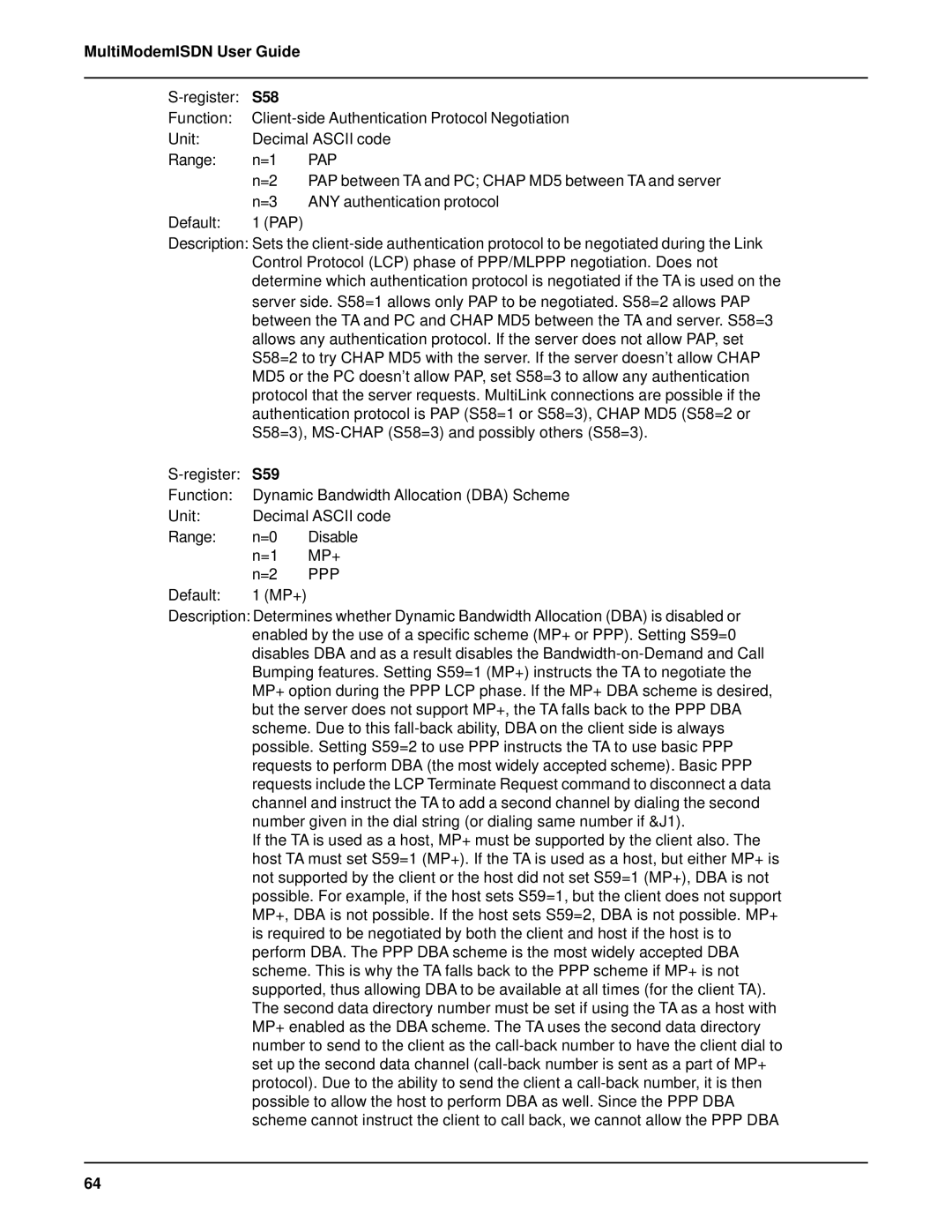
MultiModemISDN User Guide
S-register: | S58 | |
Function: | Client-side Authentication Protocol Negotiation |
Unit: | Decimal ASCII code |
Range: | n=1 | PAP |
| n=2 | PAP between TA and PC; CHAP MD5 between TA and server |
| n=3 | ANY authentication protocol |
Default: | 1 (PAP) | |
Description: Sets the client-side authentication protocol to be negotiated during the Link Control Protocol (LCP) phase of PPP/MLPPP negotiation. Does not determine which authentication protocol is negotiated if the TA is used on the server side. S58=1 allows only PAP to be negotiated. S58=2 allows PAP between the TA and PC and CHAP MD5 between the TA and server. S58=3 allows any authentication protocol. If the server does not allow PAP, set S58=2 to try CHAP MD5 with the server. If the server doesn’t allow CHAP MD5 or the PC doesn’t allow PAP, set S58=3 to allow any authentication protocol that the server requests. MultiLink connections are possible if the authentication protocol is PAP (S58=1 or S58=3), CHAP MD5 (S58=2 or S58=3), MS-CHAP (S58=3) and possibly others (S58=3).
S-register: | S59 | |
Function: | Dynamic Bandwidth Allocation (DBA) Scheme |
Unit: | Decimal ASCII code |
Range: | n=0 | Disable |
| n=1 | MP+ |
| n=2 | PPP |
Default: | 1 (MP+) | |
Description: Determines whether Dynamic Bandwidth Allocation (DBA) is disabled or enabled by the use of a specific scheme (MP+ or PPP). Setting S59=0 disables DBA and as a result disables the Bandwidth-on-Demand and Call Bumping features. Setting S59=1 (MP+) instructs the TA to negotiate the MP+ option during the PPP LCP phase. If the MP+ DBA scheme is desired, but the server does not support MP+, the TA falls back to the PPP DBA scheme. Due to this fall-back ability, DBA on the client side is always possible. Setting S59=2 to use PPP instructs the TA to use basic PPP requests to perform DBA (the most widely accepted scheme). Basic PPP requests include the LCP Terminate Request command to disconnect a data channel and instruct the TA to add a second channel by dialing the second number given in the dial string (or dialing same number if &J1).
If the TA is used as a host, MP+ must be supported by the client also. The host TA must set S59=1 (MP+). If the TA is used as a host, but either MP+ is not supported by the client or the host did not set S59=1 (MP+), DBA is not possible. For example, if the host sets S59=1, but the client does not support MP+, DBA is not possible. If the host sets S59=2, DBA is not possible. MP+ is required to be negotiated by both the client and host if the host is to perform DBA. The PPP DBA scheme is the most widely accepted DBA scheme. This is why the TA falls back to the PPP scheme if MP+ is not supported, thus allowing DBA to be available at all times (for the client TA). The second data directory number must be set if using the TA as a host with MP+ enabled as the DBA scheme. The TA uses the second data directory number to send to the client as the call-back number to have the client dial to set up the second data channel (call-back number is sent as a part of MP+ protocol). Due to the ability to send the client a call-back number, it is then possible to allow the host to perform DBA as well. Since the PPP DBA scheme cannot instruct the client to call back, we cannot allow the PPP DBA

